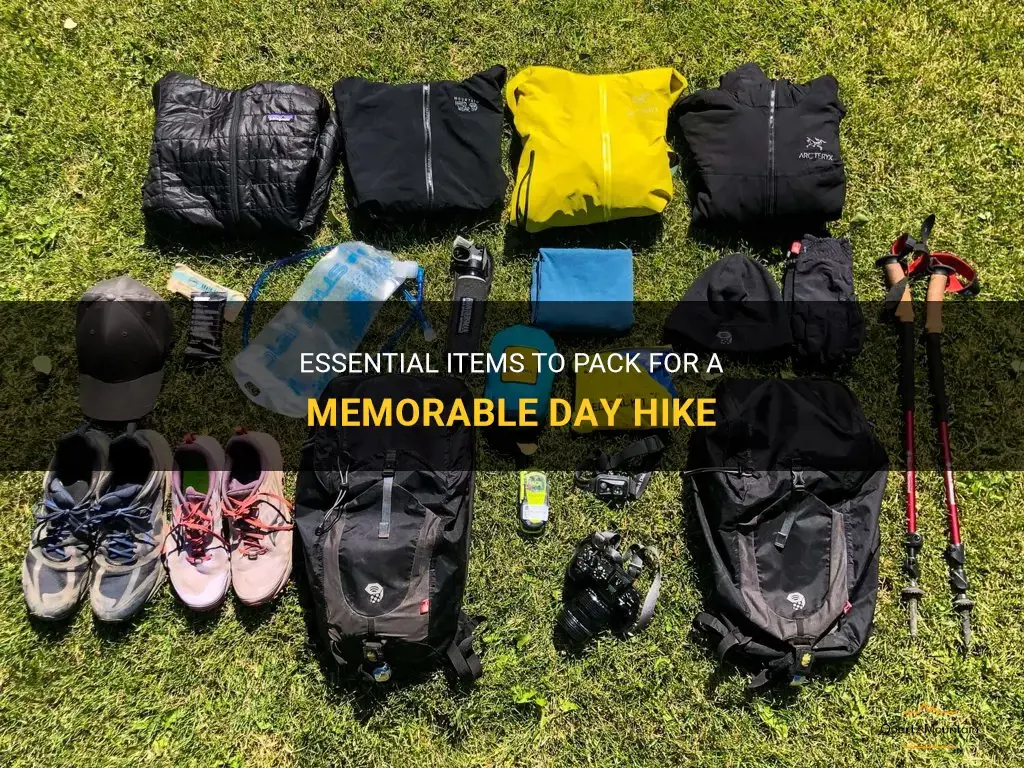
Are you planning a day hike and want to make sure you're fully prepared? Look no further! In this article, we will walk you through the essential items you need to pack for a memorable day hike. From hydration and food to navigation and first aid, we've got you covered. So, grab your backpack and let's dive in!
| Characteristics | Values |
|---|---|
| Duration | 4-8 hours |
| Distance | 5-10 miles |
| Difficulty | Moderate |
| Terrain | Varies (mountains, forests, etc.) |
| Elevation Gain | Varies (500-2000 ft) |
| Weather | Check forecast |
| Water | At least 2 liters |
| Food | Snacks, lunch |
| Backpack | 20-30L |
| Map | Topographic map or trail guide |
| Compass | Optional |
| Sun Protection | Hat, sunglasses, sunscreen |
| Clothing | Layered, moisture-wicking and insulating materials |
| Footwear | Comfortable hiking boots or shoes |
| First Aid Kit | Bandages, antiseptic, pain relievers |
| Emergency | Whistle, flashlight, fire starter |
| Phone | Fully charged |
| Camera | Optional |
| Insect Repellent | Optional |
| Toilet Paper | Optional |
| Trekking Poles | Optional |
| Trash Bag | To pack out trash |
| Leave No Trace | Practice leave no trace principles |
| Emergency Contact | Leave itinerary with someone |
What You'll Learn
- What essential items should I pack for a day hike?
- How much water should I bring on a day hike and what is the best way to carry it?
- What type of clothing and footwear is best suited for a day hike?
- Are there any specific safety items or equipment that I should always have with me on a day hike?
- Are there any additional items or gear that you recommend bringing on a day hike for added comfort or convenience?

What essential items should I pack for a day hike?
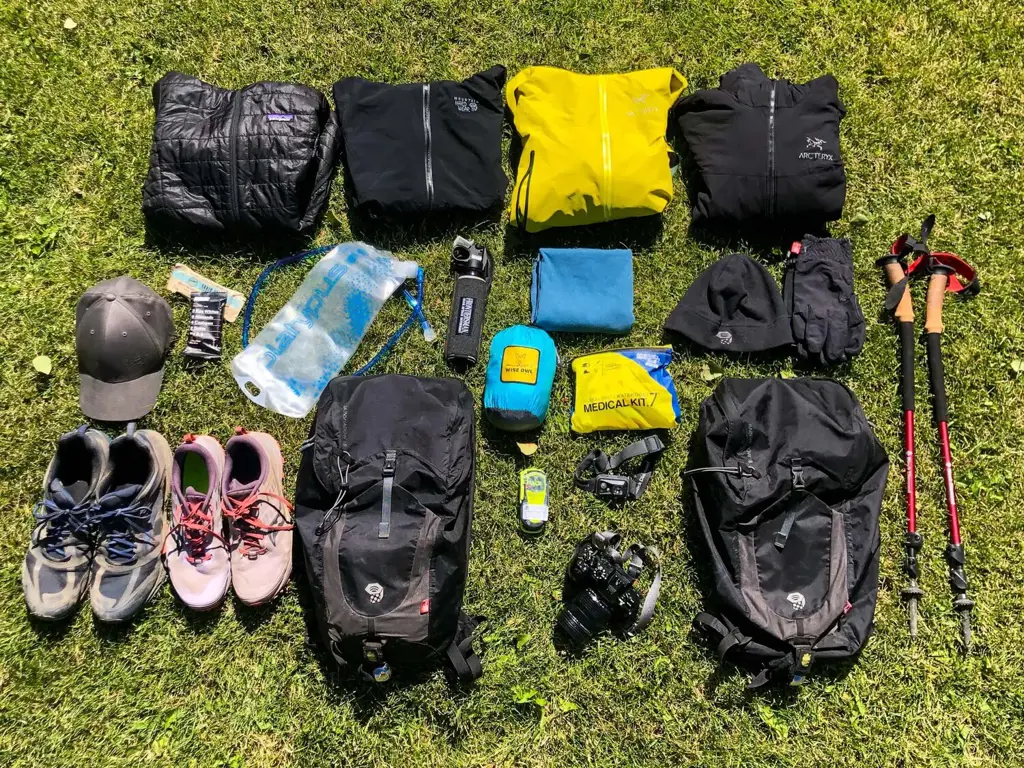
When planning for a day hike, it is important to pack the essential items to ensure a safe and enjoyable experience. Whether you are a seasoned hiker or a beginner, having the right gear can make a big difference in your overall comfort and preparedness. Here are some essential items you should consider packing for a day hike.
- Backpack: A good backpack is essential for carrying all your gear. Look for one that is comfortable, lightweight, and has multiple compartments for easy organization.
- Map and Compass: Even if you are familiar with the trail, it is always a good idea to have a map and compass as a backup. These tools can help you navigate in case you get lost or need to find an alternate route.
- First Aid Kit: Accidents can happen, so it is important to have a basic first aid kit with you. Include items such as band-aids, adhesive tape, antiseptic wipes, pain relievers, and any necessary prescription medications.
- Water: Staying hydrated is crucial during a hike. Carry enough water to last the entire duration of your hike, and consider bringing a water filter or purification tablets in case you need to refill from a natural water source.
- Snacks: Pack high-energy snacks such as trail mix, granola bars, or dried fruit to keep your energy levels up during the hike. Avoid heavy, greasy foods that can weigh you down.
- Extra Clothing: Depending on the weather and terrain, you may need to pack extra clothing layers. A lightweight, waterproof jacket and a hat are essential, even on sunny days. Bring extra socks in case your feet get wet or blistered.
- Sun Protection: Protect your skin and eyes from the sun's harmful rays by packing sunscreen, sunglasses, and a hat. Consider wearing long sleeves and pants to provide additional protection.
- Insect Repellent: Depending on the location and time of year, insects can be a nuisance during a hike. Pack insect repellent to ward off mosquitoes, ticks, and other biting pests.
- Multi-tool: A multi-tool with attachments such as a knife, can opener, and screwdriver can come in handy in various situations. Choose a lightweight and compact option that can fit easily in your backpack.
- Emergency Shelter: While not always necessary, having an emergency shelter such as a lightweight tent or bivy sack can provide protection in case of unexpected weather changes or if you need to spend the night outdoors.
In addition to these essential items, it is important to pack appropriate clothing and footwear for the hike. Dress in layers to accommodate changing weather conditions and wear sturdy, comfortable shoes or boots with good traction to prevent slips and falls.
Remember to always check the weather forecast and trail conditions before heading out on a hike. It is also a good idea to let someone know your hiking plans and estimated return time. With proper preparation and the right gear, you can have a safe and enjoyable day hike.
Packing Essentials for a Successful Dance Competition
You may want to see also

How much water should I bring on a day hike and what is the best way to carry it?
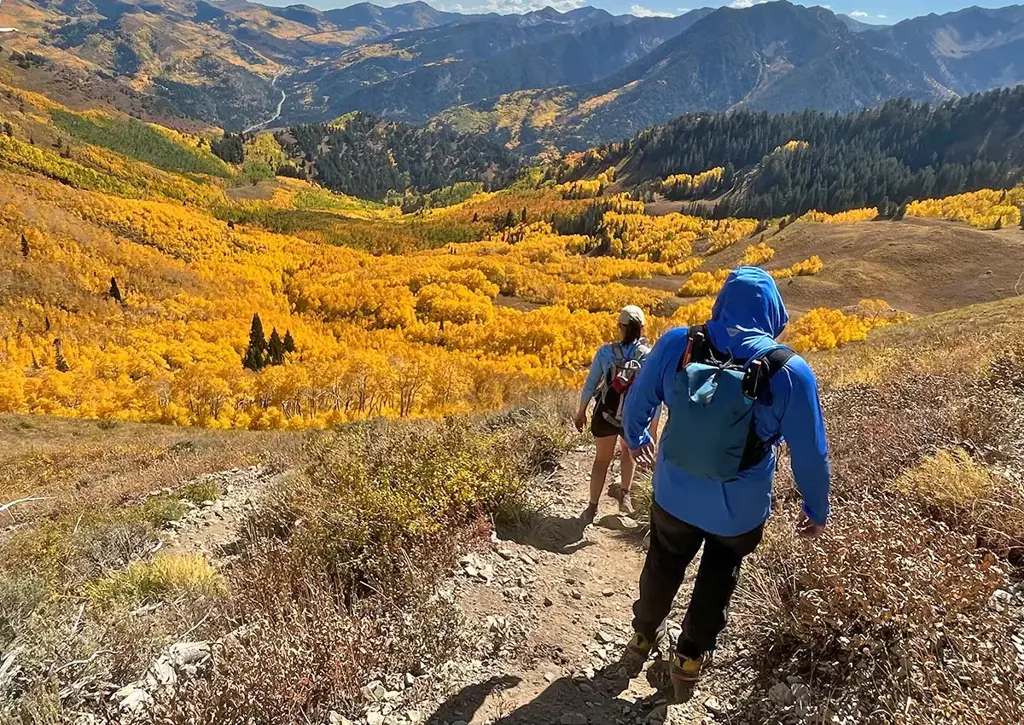
When going on a day hike, it is crucial to stay properly hydrated. Dehydration can lead to fatigue, dizziness, and even heat stroke. Therefore, it is important to plan ahead and bring enough water with you on your hike. This article will discuss how much water you should bring and the best way to carry it for a day hike.
Determine your water needs:
The amount of water you need to bring on a hike will depend on various factors such as the length and intensity of the hike, the weather conditions, and your personal hydration needs. As a general guideline, it is recommended to bring at least 2 liters (or 68 ounces) of water per person for a full-day hike.
Consider the weather conditions:
If you are hiking in hot and sunny conditions, you may need to bring even more water to compensate for the increased sweat and water loss. It is important to stay hydrated and drink water consistently throughout the hike to prevent dehydration.
Pack water bottles or hydration bladder:
The best way to carry water on a day hike is by using either water bottles or a hydration bladder. Water bottles are a popular choice as they are easy to use and carry. Look for lightweight and durable bottles that are easy to open and close. Opt for bottles with a built-in filter if you are hiking in areas where water sources might not be readily available.
On the other hand, hydration bladders are a convenient option as they allow you to drink water without stopping or taking off your backpack. They are lightweight, fit snugly into most backpacks, and have a tube that can be easily accessed while hiking. However, hydration bladders require regular cleaning and maintenance to prevent bacteria growth.
Use a backpack with a hydration system:
If you decide to use a hydration bladder, it is best to choose a backpack that has a built-in hydration system. These backpacks have a dedicated sleeve or compartment for the hydration bladder and a hole for the tube to come through. This ensures easy access and prevents the bladder from shifting or leaking while hiking.
Additional water sources:
Although bringing enough water is essential, it is always a good idea to be prepared and know where you can find additional water sources along the trail. Research the hiking route beforehand and see if there are any streams, lakes, or water refill stations available. This will allow you to plan your water consumption accordingly and replenish your supply if needed.
Consider electrolyte replenishment:
When hiking for extended periods or in hot weather conditions, it is not only important to drink water but also to replenish electrolytes lost through sweat. Electrolyte tablets or powders can be added to your water to help replenish these essential minerals and enhance hydration.
In conclusion, staying properly hydrated is crucial for a safe and enjoyable day hike. Bring at least 2 liters of water per person, or more if hiking in hot conditions. Choose between water bottles or hydration bladders based on your personal preference and ease of use. Consider a backpack with a built-in hydration system for convenience. Be aware of additional water sources along the trail and replenish your water supply as needed. Lastly, consider adding electrolyte supplements to your water for optimal hydration. With these tips in mind, you can ensure a well-hydrated and enjoyable day hike experience.
Essential Items for Backpacking in Japan: What to Pack for an Unforgettable Adventure
You may want to see also

What type of clothing and footwear is best suited for a day hike?

When preparing for a day hike, it is important to choose clothing and footwear that will keep you comfortable and protected throughout the journey. Whether you are a seasoned hiker or new to the sport, having the right gear can make a significant difference in your overall experience. In this article, we will discuss the types of clothing and footwear that are best suited for a day hike, taking into consideration both scientific knowledge and practical experience.
Clothing plays a crucial role in regulating body temperature and protecting you from the elements. The key is to dress in layers, allowing you to adjust your outfit as needed. Start with a moisture-wicking base layer, such as a synthetic or merino wool shirt. This will help keep sweat away from your skin and prevent you from feeling clammy. Avoid cotton, as it retains moisture and can lead to discomfort and even hypothermia in colder weather.
On top of your base layer, add an insulating mid-layer, such as a lightweight fleece or down jacket. This layer will provide warmth in cooler temperatures and can be easily removed if you start to overheat. Opt for breathable and quick-drying materials to minimize sweat buildup and maximize comfort.
For the outer layer, choose a waterproof and wind-resistant jacket. This will protect you from rain, snow, and chilly winds. Look for jackets with sealed seams and adjustable hoods to ensure maximum protection. Additionally, consider pants made from materials like nylon or polyester that offer water resistance and durability.
When it comes to footwear, comfort and support are paramount. Invest in a sturdy pair of hiking boots or trail shoes that are specifically designed for outdoor adventures. Look for a pair with proper ankle support, a grippy sole for traction on various terrains, and cushioning for shock absorption. Waterproof options can also be beneficial, particularly if you will be crossing streams or encountering wet conditions.
Alongside proper clothing and footwear, don't forget to pay attention to other accessories. Wearing a hat or a cap can shield you from the sun's rays and prevent sunburn. Sunglasses with UV protection are also crucial to safeguard your eyes. Additionally, always carry a backpack with essentials such as water, snacks, a map, a compass, a first aid kit, and extra layers of clothing.
In terms of scientific research, a study published in the Journal of Sports Sciences found that breathable and moisture-wicking clothing can enhance thermal comfort and improve overall performance during outdoor activities. Another study published in the International Journal of Clothing Science and Technology highlighted the importance of proper footwear in preventing injuries and increasing walking efficiency.
In conclusion, when planning for a day hike, prioritize clothing and footwear that will keep you comfortable, protected, and able to perform at your best. Dress in layers with moisture-wicking fabrics, select a waterproof and wind-resistant jacket, and invest in quality hiking boots or trail shoes. Remember to consider scientific research alongside practical experience when making your gear choices. By doing so, you can maximize your enjoyment of the outdoors and ensure a successful day hike.
Essential Items to Pack for a Fun-Filled Camp Ozark Experience
You may want to see also

Are there any specific safety items or equipment that I should always have with me on a day hike?
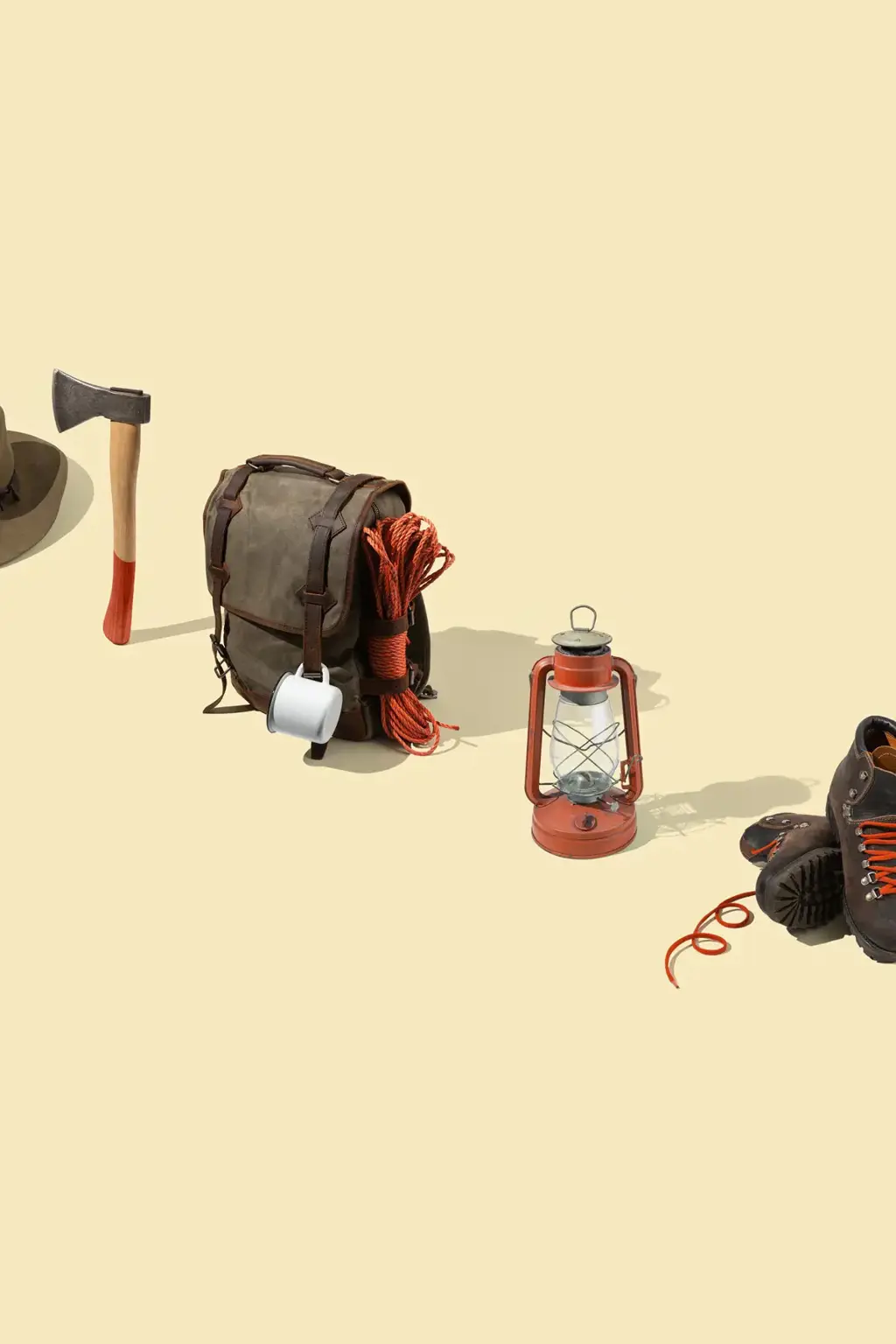
When going on a day hike, it is crucial to ensure your safety by carrying essential items and equipment with you. While it may be tempting to travel light, being prepared can save you from potential risks or emergencies. Here are some specific safety items and equipment that you should always have with you on a day hike.
Navigation Tools:
Carrying a map, compass, and/or a GPS device is essential to help you navigate through unfamiliar terrains. These tools will guide you in case you lose your way or encounter unexpected changes in the trail.
First Aid Kit:
A well-stocked first aid kit is a must-have for any outdoor adventure. Include items such as bandages, antiseptic wipes, pain relievers, blister treatment, and any personal medications you may need. Familiarize yourself with the contents of the kit and how to use them appropriately.
Adequate Clothing:
Weather conditions can change rapidly, especially in mountainous or remote areas. Dress in layers, so you can add or remove clothing to regulate body temperature. Bring a waterproof and windproof jacket, as well as a hat and gloves, even if the forecast looks favorable.
Extra Food and Water:
Keep yourself fueled and hydrated throughout your hike by packing extra food and water. High-energy snacks like trail mix, energy bars, and dried fruits are lightweight and easy to eat on the go. Carry a water bottle or hydration bladder and aim to drink at least one liter of water for every two hours of hiking.
Emergency Shelter:
In case you get stranded or injured, a lightweight emergency shelter can provide protection from the elements. Options include a space blanket, bivy sack, or a lightweight tent. Choose a shelter that is easy to set up and pack, and make sure it is suitable for the expected weather conditions.
Multi-tool or Knife:
A multi-tool or knife can be invaluable in various situations, such as repairing gear, cutting rope, or preparing food. Choose one that has a sharp blade, scissors, pliers, and other useful tools.
Sun Protection:
Even on overcast days, UV rays can still pose a danger. Protect your skin by wearing sunscreen with a high SPF, sunglasses with UV protection, and a wide-brimmed hat. Don't forget to apply lip balm with SPF to prevent chapped lips.
Communication Device:
Carry a fully charged cellphone or a dedicated emergency communication device, such as a satellite phone or an emergency beacon. These devices can be a lifeline in case of an accident or if you need to call for help.
Whistle:
A small whistle can come in handy if you get lost or need to attract attention. The sound of a whistle can carry much farther than shouting, making it easier for rescuers to locate you.
Personal Locator Beacon (PLB):
If you frequently go on remote hikes, consider investing in a personal locator beacon. When activated, it sends a distress signal with your GPS coordinates to search and rescue teams, expediting the rescue process.
Remember, these items should be packed in a comfortable backpack that distributes the weight evenly. Additionally, make sure to inform someone about your hiking plans and estimated return time. Being prepared and having the essential safety items with you can help ensure a safe and enjoyable day hike.
Essential Items to Pack for a Carnival in Mexico
You may want to see also

Are there any additional items or gear that you recommend bringing on a day hike for added comfort or convenience?
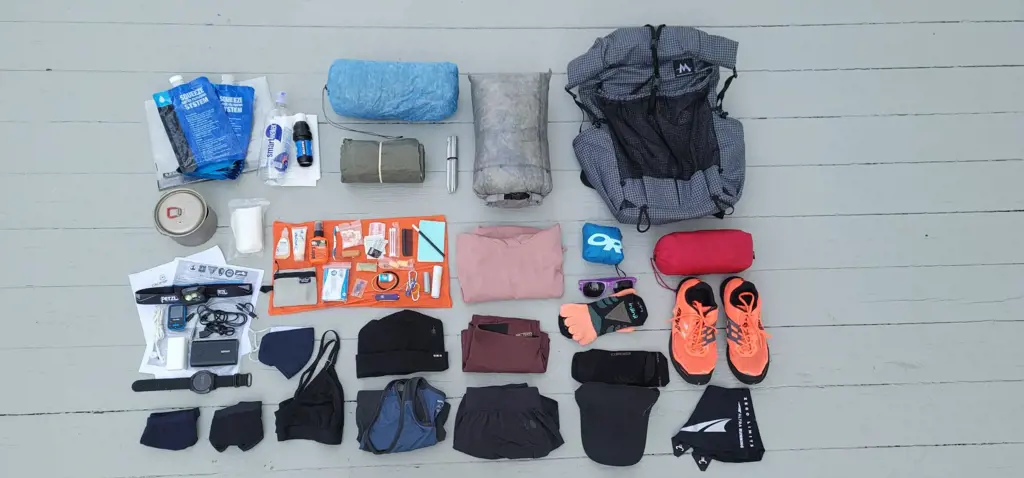
When heading out for a day hike, it's important to be prepared with the right gear to ensure comfort and convenience throughout the day. While the essentials such as appropriate footwear, clothing, and hydration are crucial, there are also additional items that can enhance your hiking experience. Here are a few recommendations for items to bring on a day hike:
- Trekking Poles: Trekking poles can provide stability and reduce the strain on your legs and joints during your hike. They help distribute weight evenly, making it easier to navigate uneven terrain and steep slopes. Trekking poles also provide extra support when crossing streams or traversing slippery surfaces.
- Portable Charger: If you plan on using your phone for navigation or taking pictures, a portable charger is a must. Hiking drains battery life quickly, especially if you're using GPS apps or taking photos, and a dead phone can leave you stranded if you need to call for help. A portable charger will ensure that your device stays powered throughout the day.
- First Aid Kit: Accidents can happen on the trail, so it's essential to carry a small first aid kit. Make sure it contains band-aids, adhesive tape, antiseptic wipes, gauze pads, and blister treatment. Additionally, consider including any personal medications or supplies you might need, such as asthma inhalers or EpiPens.
- Insect Repellent: Depending on your hiking location, insects like mosquitoes, ticks, and flies can be a nuisance. Carrying a bottle of insect repellent will help keep them at bay, allowing you to enjoy your hike without constant swatting or worrying about bug bites.
- Sun Protection: Even on cloudy days, it's crucial to protect your skin from harmful UV rays. Apply sunscreen before starting your hike and reapply it periodically throughout the day. Don't forget to wear a hat to shield your face and neck from the sun, and carry a pair of sunglasses to protect your eyes.
- Snacks and Extra Water: It's essential to stay fueled and hydrated during your hike. Pack lightweight, nutritious snacks like energy bars, nuts, and dried fruits to keep your energy levels up. Carry extra water or a water purification system to ensure you have enough to drink, especially if you're hiking in remote areas with limited water sources.
- Navigation Tools: While most people rely on their smartphones for navigation, it's always wise to carry a backup. A compass and a topographic map of the area you'll be hiking in can come in handy if your phone loses signal or runs out of battery. Familiarize yourself with basic map reading and compass skills before heading out.
- Extra Layers and Rain Gear: Weather conditions can change quickly, so it's a good idea to bring extra layers of clothing in case temperatures drop unexpectedly. Pack a lightweight, waterproof jacket or poncho to keep you dry if it starts raining. Being prepared for changing weather conditions will keep you comfortable throughout your hike.
By including these additional items in your day hike gear, you can ensure a more comfortable and convenient hiking experience. While it's essential to pack light, being prepared for potential challenges and unexpected situations will enhance your enjoyment of the great outdoors. So, load up your backpack and hit the trail, knowing that you have everything you need for a successful day hike.
Essential Packing Guide for a 4-Day Autumn Getaway: Men's Checklist
You may want to see also
Frequently asked questions
When packing for a day hike, it is important to consider the length and difficulty of the trail, as well as the weather conditions. Some essential items to pack include a backpack to carry your belongings, a map and compass or GPS device for navigation, plenty of water and snacks to stay hydrated and energized, a first aid kit for emergencies, sunscreen and insect repellent for protection, and a hat and sunglasses for sun protection. Additionally, you may want to pack extra clothing layers, a rain jacket or poncho, a headlamp or flashlight, a whistle for emergencies, and a camera or binoculars for capturing the beautiful scenery.
It is always a good idea to pack a lunch or some snacks for a day hike, especially if you will be on the trail for several hours. This will provide you with energy and help keep you fueled throughout the hike. Opt for lightweight, non-perishable items such as trail mix, energy bars, crackers, dried fruits, and sandwiches. Make sure to pack your food in a way that it won't get squished or crushed in your backpack, and bring along any necessary utensils or containers.
The type of footwear you should wear for a day hike depends on the terrain and conditions of the trail. If you are hiking on a well-maintained trail with minimal obstacles, a good pair of hiking shoes or trail runners may be sufficient. These types of shoes offer a balance between comfort and support, and are generally lighter than hiking boots. However, if you will be hiking on more rugged terrain, such as rocky or steep trails, or if the weather conditions are wet or snowy, you may want to opt for hiking boots with ankle support and a more aggressive tread for better traction and stability. It is important to choose footwear that is comfortable and provides good grip to prevent slips and falls on the trail.







